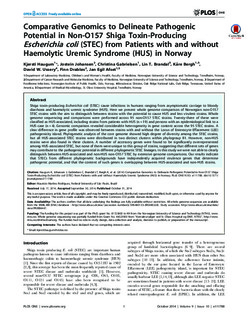| dc.contributor.author | Haugum, Kjersti | |
| dc.contributor.author | Johansen, Jostein | |
| dc.contributor.author | Gabrielsen, Christina | |
| dc.contributor.author | Brandal, Lin Thorstensen | |
| dc.contributor.author | Bergh, Kåre | |
| dc.contributor.author | Ussery, David Wayne | |
| dc.contributor.author | Drabløs, Finn | |
| dc.contributor.author | Afset, Jan Egil | |
| dc.date.accessioned | 2015-02-13T11:36:19Z | |
| dc.date.accessioned | 2015-04-24T12:39:59Z | |
| dc.date.available | 2015-02-13T11:36:19Z | |
| dc.date.available | 2015-04-24T12:39:59Z | |
| dc.date.issued | 2014 | |
| dc.identifier.citation | PLoS ONE 2014, 9(10) | nb_NO |
| dc.identifier.issn | 1932-6203 | |
| dc.identifier.uri | http://hdl.handle.net/11250/282438 | |
| dc.description.abstract | Shiga toxin-producing Escherichia coli (STEC) cause infections in humans ranging from asymptomatic carriage to bloody diarrhoea and haemolytic uremic syndrome (HUS). Here we present whole genome comparison of Norwegian non-O157 STEC strains with the aim to distinguish between strains with the potential to cause HUS and less virulent strains. Whole genome sequencing and comparisons were performed across 95 non-O157 STEC strains. Twenty-three of these were classified as HUS-associated, including strains from patients with HUS (n = 19) and persons with an epidemiological link to a HUS-case (n = 4). Genomic comparison revealed considerable heterogeneity in gene content across the 95 STEC strains. A clear difference in gene profile was observed between strains with and without the Locus of Enterocyte Effacement (LEE) pathogenicity island. Phylogenetic analysis of the core genome showed high degree of diversity among the STEC strains, but all HUS-associated STEC strains were distributed in two distinct clusters within phylogroup B1. However, non-HUS strains were also found in these clusters. A number of accessory genes were found to be significantly overrepresented among HUS-associated STEC, but none of them were unique to this group of strains, suggesting that different sets of genes may contribute to the pathogenic potential in different phylogenetic STEC lineages. In this study we were not able to clearly distinguish between HUS-associated and non-HUS non-O157 STEC by extensive genome comparisons. Our results indicate that STECs from different phylogenetic backgrounds have independently acquired virulence genes that determine pathogenic potential, and that the content of such genes is overlapping between HUS-associated and non-HUS strains. | nb_NO |
| dc.language.iso | eng | nb_NO |
| dc.publisher | Public Library of Science | nb_NO |
| dc.relation.uri | http://www.plosone.org/article/fetchObject.action?uri=info%3Adoi%2F10.1371%2Fjournal.pone.0111788&representation=PDF | |
| dc.title | Comparative genomics to delineate pathogenic potential in Non-O157 Shiga toxin-producing Escherichia coli (STEC) from patients with and without haemolytic uremic syndrome (HUS) in Norway | nb_NO |
| dc.type | Journal article | nb_NO |
| dc.type | Peer reviewed | en_GB |
| dc.date.updated | 2015-02-13T11:36:19Z | |
| dc.subject.nsi | VDP::Medisinske fag: 700::Klinisk medisinske fag: 750::Infeksjonsmedisin: 776 | nb_NO |
| dc.subject.nsi | VDP::Midical sciences: 700::Clinical medical sciences: 750::Communicable diseases: 776 | nb_NO |
| dc.source.pagenumber | -11 | nb_NO |
| dc.source.volume | 9 | nb_NO |
| dc.source.journal | PLoS ONE | nb_NO |
| dc.source.issue | 10 | nb_NO |
| dc.identifier.doi | 10.1371/journal.pone.0111788 | |
| dc.identifier.cristin | 1183175 | |
| dc.description.localcode | This is an open-access article, free of all copyright, and may be freely reproduced, distributed, transmitted, modified, built upon, or otherwise used by anyone for any lawful purpose. The work is made available under the Creative Commons CC0 public domain dedication. | nb_NO |
